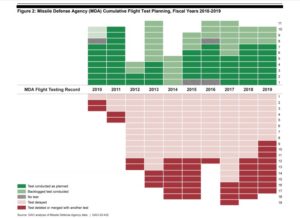An annual audit of the Missile Defense Agency (MDA) recommended it use an independent assessment of the process for developing and executing the annual missile defense system flight test plan after finding only 37 percent of tests occurred on schedule over the last decade.
The GAO’s annual report on the missile defense systems, “Assessment of Testing Approach Needed as Delays and Changes Persist,” published July 23, found that while MDA made progress in its mission defending against ballistic missiles during fiscal year 2019, the agency has still been unable to conduct flight tests as planned, a decade after changing the test plan process.

“MDA has not been able to successfully conduct planned flight tests designed to demonstrate to decision makers and warfighters that the delivered weapons can achieve its mission–defend the U.S. homeland, our allies, and deployed forces when faced with a threat. Year after year, MDA determines what tests it needs, then struggles to conduct those tests, deferring or deleting them as the year progresses.”
“This pattern demonstrates a fundamental disconnect between planning and execution. Without assessing with relevant stakeholders whether its approach could be improved, MDA risks further testing frustration and less-than-optimal data for the warfighters responsible for missile defense,” the report continued.
The GAO underwent its annual audit of the missile defense system by assessing the MDA’s planned delivery and testing baselines as expressed in the ballistic missile defense system (BMDS) accountability report for FY ’19 and the Integrated Master Test Plan (IMTP) and its midyear update. The report compared agency plans to actual delivery and testing achievement and found the results wanting.
GAO said the analysis includes flight tests for the Aegis, Terminal High Altitude Area Defense (THAAD), Ground-based Midcourse Defense (GMD), and sensors programs as well as operational tests included in the IMTPs for FY 2010-2019. It notably excludes tests where MDA participated but did not possess the primary systems under test like the Army’s Patriot or Israel Iron Dome programs.
GAO noted in FY ’19 that five planned flight tests were delayed to other years, “continuing a decade-long trend of flight test schedule instability and suggesting that MDA’s approach to developing these test plans is not adequate.”
In 2009 MDA implemented the IMTP to designate all agency elements and BMDS-level testing for the upcoming and future years and support funding requests. The IMTP identifies tests by name and specifies type of test, any targets if applicable, and the fiscal year quarter the test is planned to occur. This plan is finalized and signed annually.
The report explained the IMTP process was implemented “to address concerns that we and DoD had expressed that the original test plan was not effective for management and oversight, in part, because it was revised frequently.”
However, GAO said despite the annual IMTPs that stakeholders deem affordable and executable they have not been fully carried out each fiscal year over the last decade.
In 2009 MDA said the IMTP approach would include basing test scenarios on modeling and simulation needs and extending the test baseline to allow for a better estimation of test target, range and asset needs to support a more stable baseline.
However, GAO now says “after 10 years under this IMTP process, however, MDA has conducted only 37 percent of its planned testing as originally scheduled due to various reasons such as developmental delays, range and target availability, or changing test objectives.”
Moreover, GAO found MDA is “still consistently revising its test schedule by adding new tests and deleting or delaying the tests that were initially planned–in some cases multiple times, further into future fiscal years.”
The report reiterated in 2011 GAO found tests are changed often due to concurrent acquisition strategies, developmental delays, aggressive schedules, target availability, range availability, and test objective modifications.
In 2017 GAO reported MDA’s test schedule includes too many tests with little to no schedule margin between them. Then in a June 2019 report, GAO said MDA was also leaving too little time to analyze past test results and address issues when they emerge.
The report argued best practices show program success depends, in part, “on having a reliable schedule that is as logical and realistic as possible. Activity durations should be estimated under normal conditions, not optimal or ‘success-oriented’ conditions, which we found, in 2011, was MDA’s practice.”
Moreover, GAO emphasized in 2015 it found MDA officials told the auditors the agency does not plan for target failures, test failures or potential retests when developing the test plan “and there is no flexibility to absorb these issues.”
The report said these issues are important because going forward the agency is likely to take on additional responsibilities to respond to evolving threats, like counter-hypersonic missile defense and the new Next Generation Interceptor (NGI) program.
“Without an independent assessment of its process for developing and executing its annual BMDS flight test plan that involves relevant stakeholders, MDA will continue down the same path, increasing the risk of the same outcomes it has experienced for years– less testing than originally planned, resulting in less data available to demonstrate and validate delivered capabilities,” GAO said.